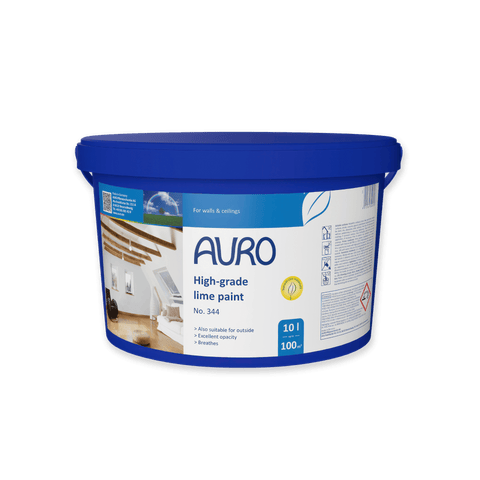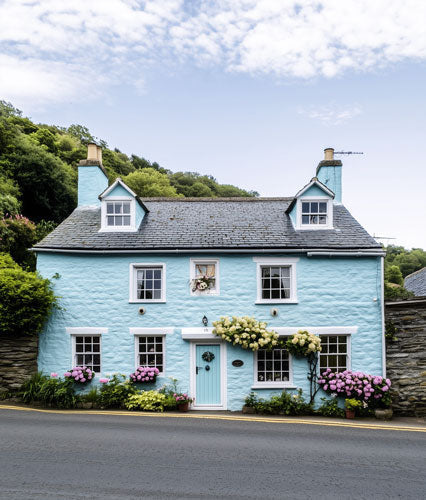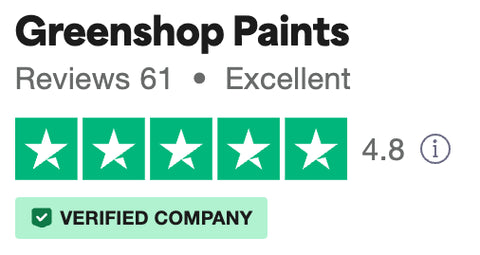Breathable masonry paint is often recommended to help keep older or heritage homes damp free and in good structural condition.
But paint doesn’t always do what it says on the tin. Many paints that claim to be breathable don’t have the right properties to protect old buildings.
Truly breathable paints allow moisture vapour to escape from the surface of external walls whilst still protecting the home from the characteristically damp British weather. This helps prevent damp becoming trapped, flaking paint, and structural issues that might develop when solid walls can’t breathe.

Pictured: Flaking and cracking on the surface of a traditional solid wall cottage painted with non breathable paint.
In this guide, we explain what breathable paint is, how to check if a paint is truly vapour permeable, and which types of breathable masonry paint work best for different surfaces.
What is Breathable Paint & Why is It Important?
Breathable paint is also referred to as vapour permeable paint and is designed to allow moisture vapour to pass through the coating without becoming trapped in the wall. This is measured by a paint’s vapour permeability or (Sd value).
In older properties, especially those built with solid walls and traditional lime mortars, breathability is vital. These walls manage moisture by absorbing and releasing it naturally. If you coat them with a plastic based paint, moisture gets trapped behind the paint layer, leading to damp patches, flaking, and even damage to the masonry itself.
Plastic or acrylic based paints sometimes claim to be “breathable”, but most have a much higher vapour resistance than natural mineral or lime paints. Always check technical data before you choose, and make sure the Sd value is what your substrate needs to remain damp and damage free.
What to Look for in Paint Technical Data Sheets
When choosing breathable paint it’s vital to look beyond the label. The technical data sheet (TDS) helps you check if the product truly allows moisture to escape.
Look for the Sd value, which shows how much the paint resists vapour movement.
- Under 0.1 is highly breathable.
- 0.1 to 0.5 is still suitable for traditional buildings.
- Above 0.5 may trap moisture in solid walls.
If the TDS doesn’t list an Sd value or vapour permeability, the paint may not be suitable for lime plaster or heritage masonry.
Check the binder too. Ingredients like acrylic, vinyl acetate, or styrene suggest a plastic-based paint that is less breathable. Instead, choose paints made with lime, potassium silicate, or casein, which support moisture movement and wall health.
Read more: Breathable paints for old houses
Is Breathable Masonry Paint Waterproof?
No, breathable masonry paint isn’t waterproof. Rather, it’s water resistant. It repels water from the surface at the same time as allowing moisture to escape from the wall.
This prevents dampness penetrating into the structure of the building, keeping it moisture and damage free. The balance of breathability and water resistance is essential in solid wall buildings without a cavity, where moisture needs to evaporate naturally.
Can breathable paint stop damp? Yes, in the sense that it can help prevent damp caused by trapped moisture. However, if a building has an underlying water ingress problem, that needs to be addressed before painting.
Choosing Breathable Masonry Paint for External Surfaces
Different substrates have different porosity and compatibility needs. Using the wrong type of paint can cause peeling, cracking, or damp issues.
Outdoor Brick
Older, softer bricks are particularly vulnerable to trapped moisture. Dense engineering bricks are less porous, but still benefit from a coating that will not seal in water vapour.
Our recommendation on the best paint for exterior brickwork would be Graphenstone GCS Exterior. This silicate based paint offers excellent adherence and longevity, particularly when paired with the Graphenstone L42 Eco Primer.
Masonry
“Masonry” covers a variety of surfaces such as stonework, blockwork, or mixed-material walls.
A breathable masonry paint helps these surfaces release absorbed moisture while providing long lasting weather protection.
Render
Not all renders are the same. Lime render is highly porous and needs a very breathable coating such as GCS Exterior, or traditional limewash.
Cement render is denser and can be more tolerant of modern coatings, but still benefits from vapour permeability in older buildings.
Heritage buildings with solid walls must be able to manage moisture naturally. A breathable paint ensures that any absorbed rain or condensation can evaporate without damaging plaster or stonework.
Products like Graphenstone GCS Exterior and Graphenstone Ambient Pro are available in approved heritage colours, making them ideal for listed properties.
Read more: Heritage paint colours
Can You Get Breathable Masonry Paint in Colours?
Yes. Modern breathable masonry paints come in a wide range of colours, making it easy to create attractive heritage paint colour schemes, or just express your creativity on your home exterior!
- Graphenstone GCS - available in 24 English Heritage colours and most of the 120 Graphenstone shades, mixed to order by our paint specialists.
- Earthborn Masonry Paint - 48 colours, including a variety of whites, creams, and heritage tones.
Mineral pigments tend to give a natural matte finish, which suits both modern and period properties.
What Paints Are Suitable for Use on Interior Masonry?
Interior masonry surfaces such as brick, stone, or render also benefit from breathability, particularly in older homes, cellars, or basements.
Choosing a breathable paint helps manage humidity, prevents condensation and damp related issues, such as mould growth, and keeps decorative finishes in good condition for longer.
Lime Paint
Lime paint is a traditional mineral paint made from slaked lime (calcium hydroxide) and natural pigments.
It has a soft, powdery matte finish and is naturally alkaline, which gives it antibacterial and anti-mould properties. It’s an ideal finish for damp prone spaces like bathrooms, kitchens, or basements.
Lime paint is also a popular choice for painting on lime plaster, stone, brick, or other breathable mineral substrates.
Read more: Limewash for period properties | What is lime paint?
Clay Paint
Clay paint is made using natural clay, minerals, and earth pigments, offering exceptional breathability along with a luxurious finish. It’s thick and creamy to apply, often giving excellent coverage in just one or two coats.
Once dry, clay paint has a beautifully soft, velvety matt appearance with a depth of colour that changes subtly in different light. It also helps regulate humidity by absorbing and releasing moisture. This paint is perfect for bedrooms, living spaces, and older interiors that need gentle moisture control.
Read more: Clay paint - breathable paint for old houses
Casein Paint
Casein paint is a traditional distemper made using milk protein (casein), chalk or lime, and natural pigments. It dries to a smooth, powdery matte finish and gives interiors a soft, breathable surface with excellent adhesion to lime plaster, stone, or bare brick.
The finish is more delicate than modern emulsions but is perfect for heritage interiors where authenticity and wall health matter.
Read more: What is casein paint?
The Importance of True Breathability
Choosing the right breathable masonry paint means more than picking a colour you like. It’s about protecting your inside and outside walls for years to come.
Whether you are painting brick, lime render, or a listed property, a truly breathable coating will help your walls manage moisture naturally, avoid damp problems, and stay looking their best.
Order a free colour chart, or get in touch for tailored advice from our team of natural paint specialists.
Further Reading: Painting over lime plaster & render | Breathable paints for cellar walls | Breathable paint for damp walls





